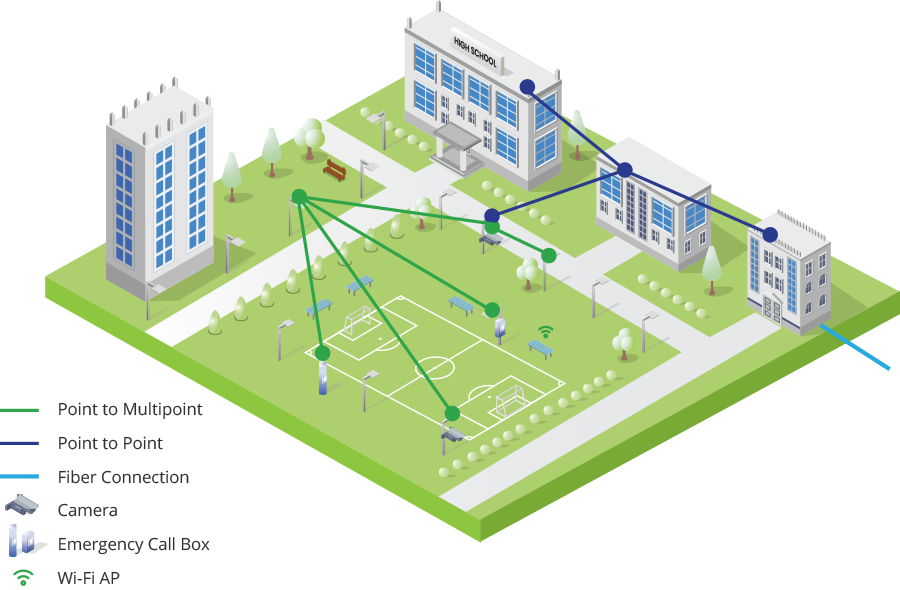When people think of education, images of classrooms with students in seats and a teacher in front often springs to mind. The bell rings, and for 6th graders and above all the way through college, students stream out of the classroom and head for their next classes. Or maybe if they have a break, they find a spot on campus to sit and read, catch up on homework, or just go to their favorite app/web site to refresh. If it’s late, and the school day is over, many will head to their cars, or buses, and start the journey home.
All of these activities are invisibly supported and enhanced by high speed connectivity. The classroom is connected to the Internet to share video, pictures and other real time topic information. As they hang out in the open air common areas or the school soccer fields or other public places, they are accessing public Wi-Fi. And when they head home, possibly at night, they walk along paths that have 911 emergency call boxes as they make their way to bike racks or, for older students, to the parking lot to drive home or catch the bus. In this parking lot, there will be lights – and video security cameras as a preventive safety measure.
In ways large and small schools have become Smart Schools or Smart Campuses. “Smart” simply indicating that people, and things, are connected with high speed access. And all the while schools have been expanding the number of “things” to connect. The very nature of those things over the past few years has doubled, quadrupled or by an order of magnitude increased the required number of bits/second. For example, a Wi-Fi AP that just five years ago was maxing out at 400 Mbps, is now supporting 1-2 Gbps. That digital IP camera supporting HD is now a 4K multi-sensor camera pushing upwards of 100 Mbps. Downloading 4K videos for the class, creating and sharing a video project or live streaming the class for remote education is now demanding symmetrical Gigabit capacities.
This process of adapting to the digital world and expanding the definition of what it means to be a Smart School or Smart Campus has progressed rapidly just in the last 5 years. Supporting this expansion of capabilities and making sure the infrastructure exists that can handle this transformation has not been easy. Fiber is one medium that can handle the demands, but schools have tight budgets, and the fiber they have is likely all the fiber they will have for some time. Hence, as that new Wi-Fi AP needs to go in the corner of the open space, or the video camera in the parking lot, it is highly likely neither of these will have a fiber strand conveniently nearby.
Enter the newest and increasingly common tool for Smart Campuses – mmWave wireless. This technology operatvideoing in the 60GHz license free band, or sometimes in the lightly licensed 70/80GHz bands, delivers multi- Gigabit performance with single digit latency. These challenging requirements are necessary in order to support the applications listed above. mmWave solutions come in a variety of packages. Some are extremely small, (insert cTU pic) but still transmitting 1Gbps, some are slightly larger and delivering 10Gbps full duplex for backhaul and major trunk lines. Some are point to point, some are point to multipoint, and others are using a mesh topology -- but all are used to easily and quickly expand the Gigabit umbrella. At Siklu, we offer the largest portfolio of mmWave solutions on the market, with the most experience and most mmWave radios deployed in the world.

These mmWave solutions are available now, today, and can be up and running in days.
We all know, principals and administrators alike, that the need for speed is not going to diminish in the future. Whatever infrastructure investment that is made needs to be future proof. It has to support today’s needs and future demands from applications we may not even have envisioned yet. Installing a multi-Gigabit mmWave solution campus wide gives them that investment assurance.
The world is becoming Smart, there can be no doubt. Smart Cities, Smart Roads, Smart streetlights and yes – Smart Schools. There can be no doubt about what the schools and their students will expect from their communications infrastructure – easy, fast access everywhere they go. In meeting these needs, mmWave wireless gets an “A.”